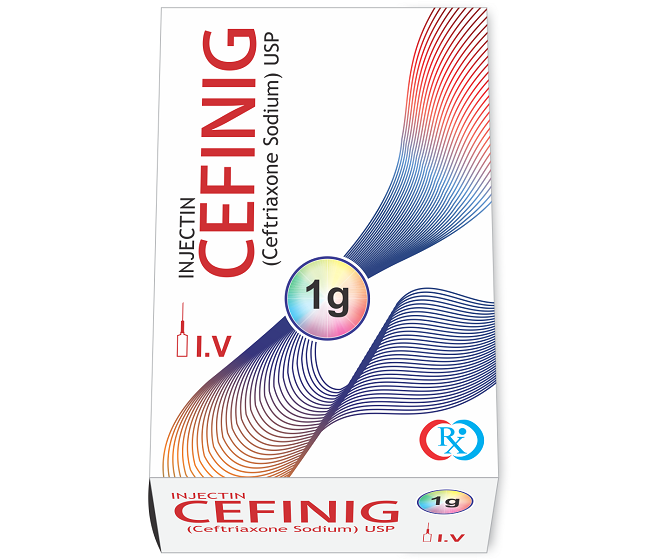
Cefinig 1 gm Inj
Long-acting broad-spectrum cephalosporin antibiotic for parenteral use Composition CEFINIG vials containing dry substance equivalent to 1gm, 250mg and 500mg Ceftriaxone.
Microbiology
The bacterial activity of Ceftriaxone results from inhibition of cell wall synthesis, Ceftriaxone exhibit in vitro activity against a wide range of gram-negative and gram-positive microorganisms. Ceftriaxone Is highly stable to most b-lactamases, both penicillinases and cephalosporinases, of gram-positive and gram-negative bacteria. Ceftriaxone is usually active against wide range of microorganisms in vitro and in clinical infections, recommended
Duration of therapy:
The duration of therapy varies according to the nature of disease. As with antibiotics therapy in general administration of CEFINIG should be continued for a minimum of 18-72 hours after the patient has become a febrile or evidence of bacterial eradication has been obtained.
Combination therapy:
Synergy between ceftriaxone and amino glycoside has been demonstrated with many gram-negative bacilli under experimental conditions. Although enhanced activity of such combination is not always predictable it should be considered in severe life-threatening infections due to microorganisms such as pseudomonas aeruginosa. Because of physical incompatibility the two drugs must be administrated parietal at the recommended dosages.
Pharmacokinetics:
Ceftriaxone is characterized by an unusually long elimination half life of approximately eight hours in healthy adults The area under the plasma concentration time curves after IV administration is identical. On intravenous against susceptible organisms are maintained for 24 hours.
| Description | Wt/Vol |
|---|---|
Cefinig 1 gm Inj |
|
| Each Vial Contains: | |
| Ceftriaxone Sodium (USP) | 1 gm |
| Infections caused by pathogens sensitive to CEFINIG e.g sepsis; meningitis; abdominal infection (peritonitis, infections of the biliary and gastrointestinal tracts); infections of the bones, joints, soft tissue, skin and wounds, infections in patients with impaired defense mechanisms, renal and urinary tract infections, respiratory tract infections, particularly pneumonia, and ear, nose and throat |
| STANDARD DOSAGE: Adults and children over twelve years: The usual dosage is 1-2 g of CEFINIG administered once daily (every 24 hours). In severe cases of infections caused by moderately sensitive organisms, the dosage may be raised to 4 g administered once daily. Neonates, infants and children up to twelve years: The following dosage schedules are recommended for once daily ADMINISTRATION: Neonates (up to two weeks): A daily dose 20-50 mg/kg body weight, not to exceed 50 mg/kg, on account of the immaturity of the infant's enzyme systems. It is not necessary to differentiate between premature and infants born at terms. Infants and children (three weeks to twelve years): A daily dose of 20-80 mg/kg or children with body weights of 50 kg or more then usual adult dosage should be used. Intravenous doses of 50 mg or more per kg should be given by infusion over at least 30 minutes. Anaphylactic shock requires immediate counter measures such as intravenous epinephrine followed by a glucocorticoid. Elderly patients: The dosages recommended for adults require no more modification in the case of geriatric patients. Meningitis In bacterial meningitis in infants and children, treatment begins with doses of 100mg/kg (not to be exceed 4 g) once daily. As soon as the causative organism has been identified and its sensitivity determined, the dosage can be reduced accordingly, the best results have been found with the following duration of therapy: Neisseria meningitis 4days Haemophilus influenza 6days Streptococcus pneumonia 7days Susceptible Enterobacteriaceae 10-14 days Gonorrhea: For the treatment of gonorrhea penicillinase producing and nonpenicillinase producing strains a single dose of 250mg of CEFINIG is recommended. Perloperatlve prophylaxis: To prevent postoperative infections in contaminated or potentially contained surgery, the recommended approach depending on the risk of infection is a single dose of 1-2g CEFINIG administered 30-90 minutes prior to surgery. Impaired renal and hepatic function: In patients with Impaired renal function, there is no need to reduce the dosage of CEFINIG provided hepatic function is intact. Only in case of preterminal renal failure (creatinine clearance < 10ml/min) should the CEFINIG dosage not exceed 2 g daily. In patients with liver damage, there is no need for the dosage to be reduced provided renal function is intact. Direction for use: As a general rule however, the solutions should be used immediately after preparation. Reconstituted solution retain their physical and chemical stability for six hours at room temperature for 24 hours. They range in color from pale yellow to amber, depending on the concentration and the length of storage. Intravenous Injection: For I.V Injection, dissolve the contents in water for injection and administer by i.v, injection lasting two to four minutes. Intravenous Infusion: The infusion should last at least 30 minutes, I.V Administration 2 g CEFINIG are dissolved in 40ml of one of the following calcium-free infusion solution: sodium, chloride 0.9%, sodium chloride 0.45% + dextrose 25%, dextrose 5%, dextrose 10% levulose 5%, dextran E% in dextrose, sterile water for injection. CEFINIG solutions should not be mixed with or piggy backed into solutions containing other antimicrobial drugs or into diluent solutions other than those listed above, owing to possible incompatibility. |
| As with other cephalosporins, anaphylactic shock cannot be ruled out even if a thorough patient history resistant to cephalosporin. |
| Undesirable effects: Cefinig is generally well tolerated. During the use of CEFINIG the following side effects, which were reversible either spontaneously or after withdrawal of the drug, have been observed. Systemic side effects: Gastrointestinal complains (about 2% of cases): loose stools or diarrhoea, nausea. vomiting stomatitis and glossitis. Hematological change (about 2%), eosinophilia, leukopenia, a granulocyte, hemolytic anemia, thrombocytopenia. Skin reactions (about 1%): allergic dermatitis, pruritus, urticaria, edema, erythema. Other rare side effects: headache and dizziness, increase in liver enzymes, gallbladder sludge, Oliguria, increase in serum phylactic or anaphylactic reactions. Pseudo membranous enterocolitis and coagulation disorders have been reported as very rare side effects. |
| Vials containing 1 g, 500 mg and 250 mg powder for injection. |
 REMEDIES INTERNATIONAL
REMEDIES INTERNATIONAL